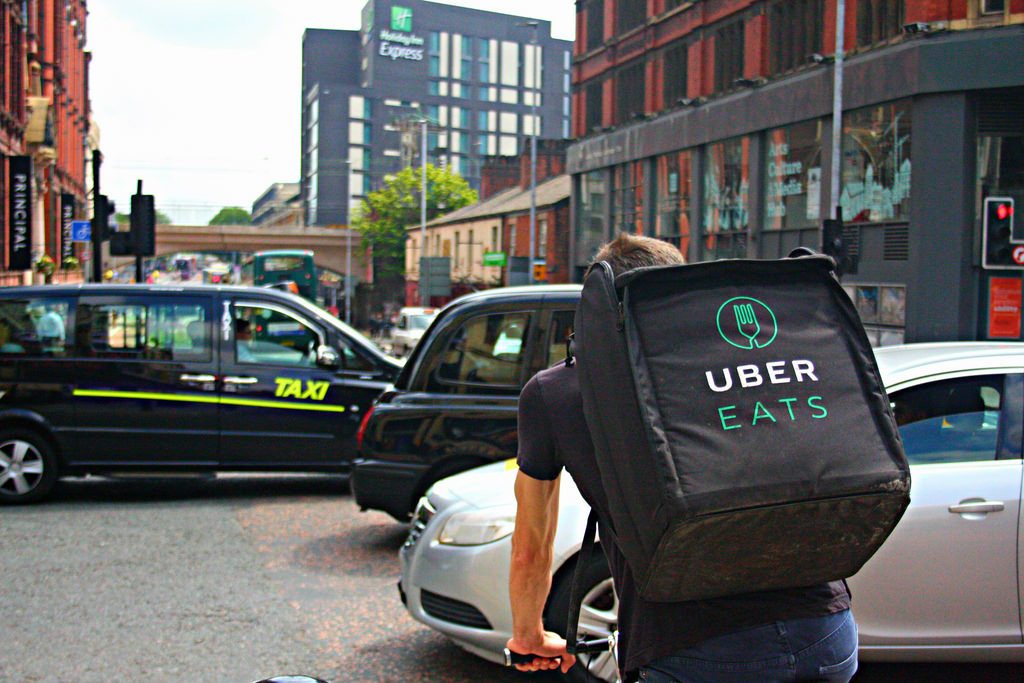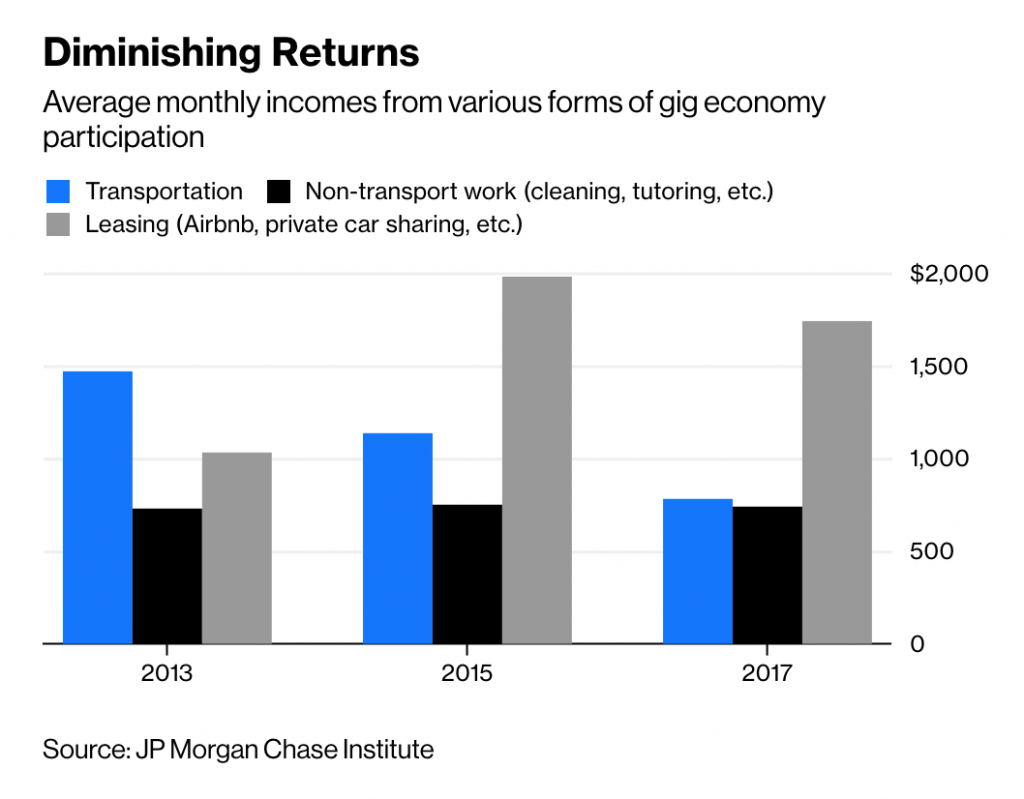If we told you a decade ago that during your trip to Paris you’d be staying in a strangers house you met online, and you’d be driven around by someone you had never met in their private car. Meanwhile, someone you sourced on a website (and never met) would be taking care of your dog back home — you’d be forgiven for thinking that we had lost our marbles!
If that weren’t bewildering enough, all of this would be done via your phone, and you’d never have to take your credit card out. Assuming you remember a time before all these everyday luxuries existed, you’d surely be left flabbergasted.
Task Rabbit, Upwork, Airbnb, Lyft, Uber, Rover, Fiverr, Postmates, Door Dash — these services have all simplified our lives in one way or another. If you’re on the supplier end in this new global sharing economy model—then your smartphone has become your lifeline. It’s your work schedule and often, the provider of some financial freedom.
This business model has many monikers — the gig economy, sharing economy, peer to peer community, the on-demand, internet or platform economy. The line between gigs and work is getting increasingly blurred. What all these concepts have in common is that they are made up of shorter-term workers that go from ‘gig to gig’ providing much needed and flexible services to many businesses around the world.
By 2020, about 43 percent of the U.S. workforce will be comprised of independent contractors and freelancers, according to Intuit. That’s almost half of all Americans. Is this because fewer jobs are available so that we have to get creative? Or are businesses and employees just seeking more flexibility? Let’s take a look.
How freelancers and contractors are changing the American workforce
There are roughly 68 million freelancers and contractors in the US today, reports McKinsey. Nearly half (46 percent) of Generation Z workers are freelancers, and that number is only expected to grow, with an estimated 61 million Gen Zers joining the workforce over the coming years.
It’s not only younger freelancers that are riding the gig economy wave. Baby boomers are in to, earning an average of $79,000 a year, while their Millennial peers earn significantly lower at $47,400. This makes sense as these senior contractors are seasoned and well-versed in their area of expertise, after having decades of experience in their field. Many companies prefer to hire an expert contractor who can come in and get the job done faster.
Men and women have slightly different reasons for participating in the gig economy. Men want to be their own bosses, while women are seeking more flexibility which is particularly important for working mothers.

Gig economy appeal

The sharing economy is indicative of the customizable life we’ve become accustomed to. For example, you can pick and choose which features you want on your phone, and you can opt for that sofa in taupe faux leather, add extra features to your new SUV, or order your Nike shoes with bespoke tick colors, laces, and biodegradable materials. The list is endless! Short-term contract work, or gigging, is just like that. You decide when you want to work, what projects you’ll undertake and for how long. It’s the polar opposite of a traditional 9-5 job.
“There are so many clients, I rarely get bored,” shared a Task Rabbit worker. There’s an element of novelty and surprise associated with freelancing in the gig economy where no two days are alike. You also get to interact with a larger variety of people on a daily basis than in a traditional job.
Studies show freelancers and contractors are often happier, healthier and enjoy an overall better work-life balance than their 9-5 counterparts. Around 64 percent say they are doing their preferred type of work and have found the perfect union between their passion and career goals.
Ripple effects of the sharing economy
1. The gig economy has disrupted industries
The rising number of freelancers and contractors has changed how we see work today and is disrupting countless industries. Leading global hotel brands are adapting to this new world by introducing services that appeal to the Airbnb generation. Instead of your run-of-the-mill hotel room, you can now rent out homey-looking Mariott or Hyatt rooms for weeks or months at a time. You can also check out of your room now from your phone and settle your bill in the elevator on the way out – without ever having to speak to a person at the reception desk.
2. The sharing economy has changed the traditional career model
Meanwhile, the sharing economy has changed the typical career ladder that was once coveted and climbed by many. The traditional employment model meant you’d stay at a company for years, starting off in a junior-level position and later becoming a supervisor or manager.
Nowadays, the possibility of having several different income streams and flexible work arrangements is making people far less likely to stay with the same employer. This presents both challenges and opportunities for employers. They simultaneously have a harder time retaining their employees, while also having much greater access to on-demand talent. People today want more mental stimulation and challenges in their careers. This not only keeps short-term workers up to date on the latest skills and trends, but it’s valuable for a company’s bottom line. For businesses, tapping into an informed and engaged workforce is a crucial part of staying ahead.
3. The gig economy offers more opportunities
Some gig workers freelance or do contract work in their spare time for some extra cash, similar to an actress who moonlights as a yoga teacher during the day. For many more, the gig economy is a means to an end. People who in the past needed to choose between earning income and providing care to loved ones (be it their kids, elderly parents or someone with an illness) can now make a living on their own terms and in their own time. Businesses can now tap into the diverse talents of vast amounts of people who, by choice or circumstance, choose not to commit to full-time employment.
However, it’s expected the gig economy landscape will change dramatically in the coming years, in both positive and negative ways. In the chart below, you can see that salaries for some types of freelancers have gone down over the last five years.
4. What are the more profitable/in-demand freelance jobs?
The most sought-after gig economy jobs over the next five years will focus on robotics, finance, artificial intelligence, and marketing. If you’re a freelancer or contractor, your best bet is to remain relevant and keep up to date with in-demand skill sets.
Ten highest-paying freelance and contract jobs of 2018:
- Artificial intelligence/ deep learning ($115.06/hour)
- Blockchain architecture ($87.05/hour)
- Robotics ($77.46/hour)
- Ethical hacking ($66.33/hour)
- Cryptocurrency ($65.37/hour)
- Amazon Web Services Lambda coding ($51/hour)
- Virtual Reality ($50.18/hour)
- React.js Developers ($40.75/hour)
- Final cut pro editors ($37.12/hour)
- Instagram marketing ($31.23/hour)
How company leaders can dip into the skilled gig worker pool
Leaders of companies and gig economy workers may have slightly different objectives. Companies are seeking to meet their business objectives, while freelancers and contractors are building their brand and have their personal passion goals at the forefront of their minds.
A report by McKinsey found that knowledge-intensive industries and creative occupations are the most significant and fastest-growing segments of the freelance economy. How can companies in these industries remain competitive when so many talented workers are leaving the traditional workforce?
The businesses that will thrive are those that learn how to embrace the gig economy. This does not mean firing your entire team and hiring remote workers, but instead embracing the mix and cultivating a robust and knowledgeable team. Embracing the fresh thinking and talent that this new mixed model brings to your company, and running with it to achieve more, faster.
There are tons of opportunities in which leaders might want to hire contractors. This could range from expanding to new markets with lower upfront investment, hiring more workers during busier seasons, diversifying your talent resources and outsourcing one-off projects or even, getting senior contractors in to drive bigger strategic business moves at critical company development points.
With a few exceptions, the bulk of the sharing economy exists online. Effective communication is the basis for a successful workflow and exchange. Freelancers and contractors can face particular challenges when it comes to staying productive and organized. Short-term gig workers have to multitask, handle various deadlines simultaneously and meet the needs of several clients.
Brief is a robust productivity app that keeps entrepreneurs and freelancers on the same page in real time. Merge team collaboration between in-house and remote gig workers in Hubs. Work can be done remotely and submitted via Brief’s file sharing feature. Quickly access all files from one central location while avoiding multiple people working on the same task.
Brief is designed for focused and productive work, with an intentionally-minimalist dashboard that combines chat, video, to-do lists and file sharing in one place. Ensure work efficiency by chatting in real time, and if any topic requires further clarification, you can easily hop onto a video call to get the team on the same page.
When hiring a freelancer or contractor, keep in mind the slight differences in the process. A full-time employee may require a full-length job interview and you need to ensure they are a company culture match. This is not necessary with gig workers. Instead, project samples and necessary skills to complete a project are more important. You’re looking for someone who can do the job efficiently with minimal supervision and training.
When it comes to writing the job description for a gig worker, consider cutting out the unnecessary details that don’t apply to them and get straight to the specific project scope. Highlight specific skills required and measurable deliverables. This also makes it easier for the freelancer to decide whether they’re a good match or not.
All in all, conventional wisdom says that one of the best ways for workers to stay relevant — whether they are freelancers or in traditional 9-5 jobs— is to continually invest in training and learning. By following the strategies outlined here, you can prepare yourself and your company for this new frontier of employment. The future of work is changing, and the tools are here to help you meet these changes with open arms.
Are you a freelancer or contractor? What has your experience been like? What are your thoughts on the gig economy? Share them in the comments below; we’d love to hear from you.
Deeper focus and effective communications are just a click away. Join Brief for free and invite your team in seconds.







